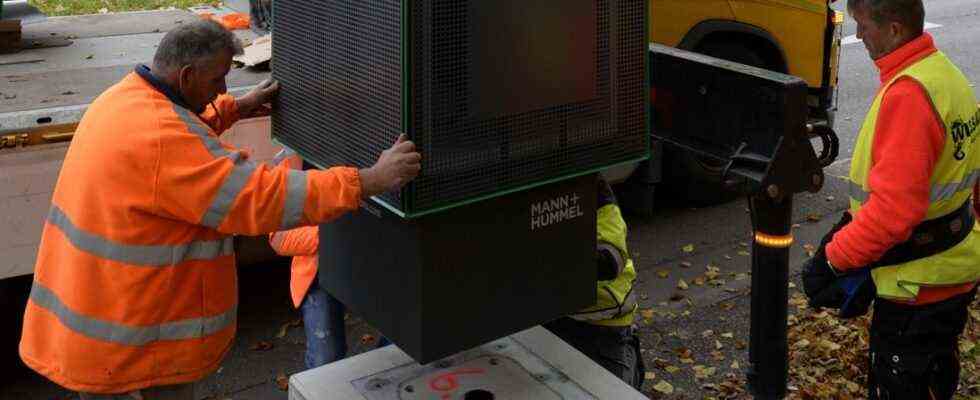What has been standing on the west side of Landshuter Allee since Wednesday are neither abstract sculptures nor oversized loudspeakers, even if it might look like them. The 3.60 meter high pillars, each consisting of three cubes, are the new filter systems that will now purify the air on Germany’s dirtiest street for two years. As is well known, Landshuter Allee reached a peak value of 54 micrograms per cubic meter of air last year for the concentration of nitrogen dioxide (NO2) on average, thus again exceeding the EU-wide limit of 40 micrograms. So now the company Mann + Hummel from Ludwigsburg in Baden-Württemberg has set up seven such filter columns between Blutenburg and Wilderich-Lang-Straße, with two more to be added at a later date. These suck in the dirty air with fans, the filters are supposed to bind more than 80 percent of the NO2, the ozone and the fine dust from the sucked in ambient air. According to the manufacturer, a three-part filter column can clean 14,500 cubic meters of air every hour.
The project was initiated by the Bavarian Ministry of the Environment and the Munich Department for Climate and Environmental Protection. Scientific support is provided by four Bavarian universities under the leadership of the University of Bayreuth. Anke Nölscher stands next to one of the new pillars at the confluence of Hirschbergstrasse and Mittlerer Ring. Shortly before noon there is no rush hour there, but as at any time of the day or night, so much traffic rushes by that you can smell it and have to talk a little louder because of the noise. Nölscher is Professor of Atmospheric Chemistry in Bayreuth and coordinates the scientific investigations. Among other things, she is also in charge of the three-year ultrafine dust measurements at Munich Airport. At Landshuter Allee, she expects to find out more about how various factors affect air pollution and how effectively the filter columns work in the long-term test in Munich.
The air pollution is measured in the side streets during the test phase
The filter systems could later become part of air pollution control plans. There is a reason why the pillars are set up on the west side of the street, of all places, but not opposite, explains Nölscher. “This side of the street is particularly polluted,” she says. Landshuter Allee, which runs in a north-south direction, is to be understood as a wind tunnel in which the eddies that are created transport the pollutants mainly to the west. But the exact effects of the wind and weather conditions on the NO2 pollution are the subject of the scientific investigation. The University of Augsburg also measures the air pollution in the side streets during the two-year test phase, the Technical University of Munich keeps an eye on the traffic density, and the East Bavarian Technical University of Regensburg evaluates the filters. The latter must be changed every six to eight weeks. The scientists’ measuring devices also record how the NO2 load fluctuates when the filter columns are switched off for an hour.
In Stuttgart at the “Am Neckartor” measuring station, says Thomas Michalak, Head of Sales at Mann + Hummel, the filter columns have been able to reduce NO2 pollution by an average of nine percent and fine dust pollution by seven percent since 2018. Because the city of Stuttgart has also imposed a driving ban for older diesel vehicles and a speed limit of 40 kilometers per hour, the street Am Neckartor has lost its dubious title as the dirtiest street on Landshuter Allee.
The company has distributed a total of 140 systems worldwide
In June, Mann + Hummel also installed filters in Ludwigsburg. In total, the company has distributed around 140 systems around the world, for example also in the Paris subway, in order to reduce fine dust pollution there. “With very good results,” says Michalak. You can only say more details after a detailed evaluation. In the company that started out as an automotive supplier and today manufactures filter systems for various uses, it is believed that the need for external filters will continue to grow, especially in Asia.
In Munich, the air quality should not be improved by filter systems alone. The city has already emphasized in advance that this is not a long-term solution. The goal is still to reduce emissions by reducing individual motorized traffic. An expansion of the Landshuter-Allee tunnel, as it was planned for a long time, should no longer take place by resolution of the green-red town hall coalition.

